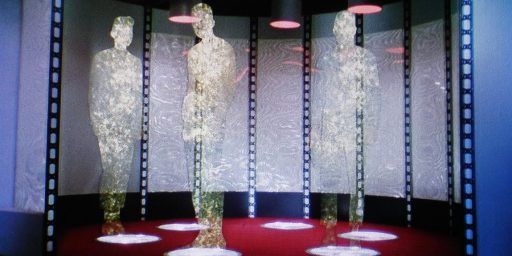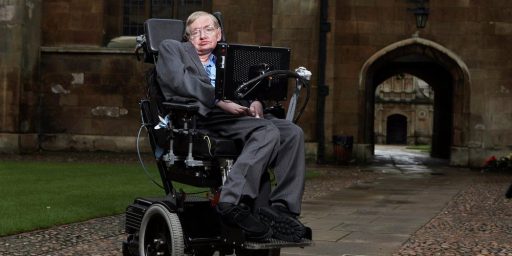Quantum Internet Operating at Los Alamos Since 2011
A super-secret, super-secure alternative internet has been operating at Los Alamos National Labs for two and a half years.
A super-secret, super-secure alternative internet has been operating at Los Alamos National Labs for two and a half years.
MIT Technology Review (“Government Lab Reveals It Has Operated Quantum Internet for Over Two Years“):
One of the dreams for security experts is the creation of a quantum internet that allows perfectly secure communication based on the powerful laws of quantum mechanics.
The basic idea here is that the act of measuring a quantum object, such as a photon, always changes it. So any attempt to eavesdrop on a quantum message cannot fail to leave telltale signs of snooping that the receiver can detect. That allows anybody to send a “one-time pad” over a quantum network which can then be used for secure communication using conventional classical communication.
That sets things up nicely for perfectly secure messaging known as quantum cryptography and this is actually a fairly straightforward technique for any half decent quantum optics lab. Indeed, a company called ID Quantique sells an off-the-shelf system that has begun to attract banks and other organisations interested in perfect security.
[…]
Today, Richard Hughes and pals at Los Alamos National Labs in New Mexico reveal an alternative quantum internet, which they say they’ve been running for two and half years. Their approach is to create a quantum network based around a hub and spoke-type network. All messages get routed from any point in the network to another via this central hub.
This is not the first time this kind of approach has been tried. The idea is that messages to the hub rely on the usual level of quantum security. However, once at the hub, they are converted to conventional classical bits and then reconverted into quantum bits to be sent on the second leg of their journey.
So as long as the hub is secure, then the network should also be secure.
The problem with this approach is scalability. As the number of links to the hub increases, it becomes increasingly difficult to handle all the possible connections that can be made between one point in the network and another.
Hughes and co say they’ve solved this with their unique approach which equips each node in the network with quantum transmitters-i.e., lasers-but not with photon detectors which are expensive and bulky. Only the hub is capable of receiving a quantum message (although all nodes can send and receiving conventional messages in the normal way).
That may sound limiting but it still allows each node to send a one-time pad to the hub which it then uses to communicate securely over a classical link. The hub can then route this message to another node using another one time pad that it has set up with this second node. So the entire network is secure, provided that the central hub is also secure.
The big advantage of this system is that it makes the technology required at each node extremely simple-essentially little more than a laser. In fact, Los Alamos has already designed and built plug-and-play type modules that are about the size of a box of matches. “Our next-generation [module] will be an order of magnitude smaller in each linear dimension,” they say.
This is well beyond my technical expertise but, assuming that the technology scales and becomes affordable, it should solve a lot of the security issues associated with sending sensitive data online. Presumably, though, Facebook and Google will still have complete access to our information.





This is confirmation that the government has been working on time travel.
Amazon.com, too. At some point, a user will click on a friendly button “to make your shopping easier” and inadvertantly release all their passwords to the cloud for picking.
This is really interesting. For decades (?), I’ve followed this technology in the popular press from the point of “Interesting theoretical possibility, but little possibility of actual use or even ability to prove” to “Yeah, got that.” Same goes for quantum computing. Someone once commented to the effect that “common sense” is the biggest impediment to progress because a major advance, almost by definition, defies common sense. At least until it becomes common sense itself.
Is the Heisenberg Uncertainty Principle a factor here? That is; if you are making sense in your message is the message unintelligible and if you are babbling nonsense will the message be clear?
My understanding is that calling this technology “perfectly” secure is a leap, although it may be 99.99999999% secure. I don’t fully understand all the math, but the detection of eavesdropping relies on probabilities and eavesdropping thresholds.
@Franklin
In practice, our ability to detect tampering with the signal isn’t perfect, and that opens the door for cracking quantum cryptography. It’s already happened:
Basically, as long as our ability to detect tampering with the signal isn’t perfect, there is some possibility for eaves-dropping. But it’s still probably better than the alternatives, and I think it’s likely we’ll get better and better at detecting tampering.
@Franklin: It’s physically impossible to hide your tracks, but it’s humanly possible for someone to miss them.
@ Tyrell
Hey, that makes some of the Benghazi scenarios Fox News is pushing possible!
Actually, your major problem is to keep the whole system isolated enough. We’ve got problems with routers….and your major problem with qubit technology is the majority of technologies require maintaining the system at mK temperatures–not easy! photonic-based systems don’t have the temperature problems, but you still have to worry about vibrations….
@MarkedMan: Look at what D-Wave has been putting out. They have come up with something called Adiabatic Quantum Computing (which uses a different set of wavefunctions that is standard in “classic” quantum computing) which seems to be much more realizable in reality.
The major problem is keeping decoherence from happening. Shor’s original patent assumed that decoherence would only affect one out of a multiple of linked qubits–in reality, the entire wavefunction collapses.
(There’s also a lot of 101 and 112 problems with many present patents, but I digress…)
@grumpy realist: The D-Wave system is kept at near absolute zero.
Y’all are missing the point here. The government insists that there be a backdoor to ALL secure communications so they can spy if they feel like it. Any backdoor is a vulnerability that can and eventually will be exploited. No matter how secure the technology is, the government by it’s nature, will make it insecure.
@Alex Knapp: Exactly. The only non-mK systems I’ve run across are photonic-based systems. I haven’t done enough work in the field to figure out why they haven’t cracked the multi-qubit decoherence problems even with photonic qubits, but D-Wave seems to be the only player around that has figured out how to keep the whole mess talking to itself long enough to be useful.